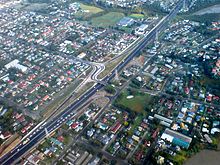Otahuhu, New Zealand
| Ōtāhuhu | |
|---|---|

Part of eastern Ōtāhuhu from the air
|
|
 |
|
| Basic information | |
| Local authority | Auckland Council |
| Population | 11,991 (2001) |
| Facilities | |
| Train station(s) | Otahuhu Train Station |
| Surrounds | |
| North | Mount Wellington |
| Northeast | (Tamaki River), Pakuranga |
| East | (Tamaki River), East Tamaki |
| Southeast | Ōtara |
| South | Middlemore, Papatoetoe |
| Southwest | Favona, Mangere East |
| West | (Mangere Inlet) |
| Northwest | Westfield |
Ōtāhuhu is a suburb of Auckland 13 kilometres (8.1 mi) to the southeast of the city centre, on a narrow isthmus between an arm of the Manukau Harbour to the west and the Tamaki River estuary to the east. The isthmus is the narrowest connection between the North Auckland Peninsula and the rest of the North Island, being only some 1200 metres wide at its narrowest point, between the Ōtāhuhu Creek and the Mangere Inlet. As the southernmost suburb of the former Auckland City it is considered part of South Auckland.
The suburb's name is taken from the Māori name of a volcanic cone also known as Mount Richmond. The name refers to "the place of Tāhuhu", a Maori ancestor Tāhuhu-nui-a-Rangi who settled the area. In colloquial speech locals typically shorten the name to "Otahu".
The suburb was established in 1847 as a fencible settlement, where soldiers were given land with the implied understanding that in wartime, they would be raised as units to defend it (however, the eventual fighting a decade later used professional soldiers instead). Most early features from this time have disappeared, however, such as a stone bridge built by the fencibles that had to make way to a widening of Great South Road.
Ōtāhuhu was home to the country's first supermarket, and Ōtāhuhu College, to which several famous personalities went, including heavyweight boxing champion David Tua, former prime minister David Lange, and ex-Manukau City Mayor, Sir Barry Curtis.
Ōtāhuhu, in its position on a narrow section of the Auckland Isthmus, is an important part of Auckland's southern transportation approaches for both road and rail, containing a combined bus interchange and Otahuhu Train Station. The new transport centre opened on 29th October 2016 as a joint Auckland Transport and New Zealand Transport Association initiative costing NZ$28M.
...
Wikipedia
